Professional Project: Evaluating Lean Six Sigma in Singapore Logistics
VerifiedAdded on 2022/11/19
|24
|6411
|2
Project
AI Summary
This professional project investigates the application of Lean Six Sigma (LSS) within the logistics and supply chain industries of Singapore. The project begins with an introduction to LSS, highlighting its focus on collaborative team efforts to improve system performance by eliminating waste and reducing variation. The research explores the reasons for choosing this topic, emphasizing LSS's role in performance improvement and customer satisfaction. Academic objectives include understanding LSS concepts, identifying its benefits, and analyzing its impact on performance within the supply chain. The project is structured into three main sections: an introduction, literature review, and a conclusion. The literature review delves into the theoretical and methodological findings related to LSS, including its principles, tools (such as Value Stream Mapping, Kaizen, and Just in Time), and benefits. The project concludes with a summary of findings, a review of objectives, identification of limitations, and suggestions for future research. The project emphasizes the significance of LSS in enhancing efficiency, reducing errors, and building responsive supply chains within the Singaporean context.

Running head: PROFESSIONAL PROJECT
Professional Project
Name of Student
Name of University
Author Note
Professional Project
Name of Student
Name of University
Author Note
Paraphrase This Document
Need a fresh take? Get an instant paraphrase of this document with our AI Paraphraser
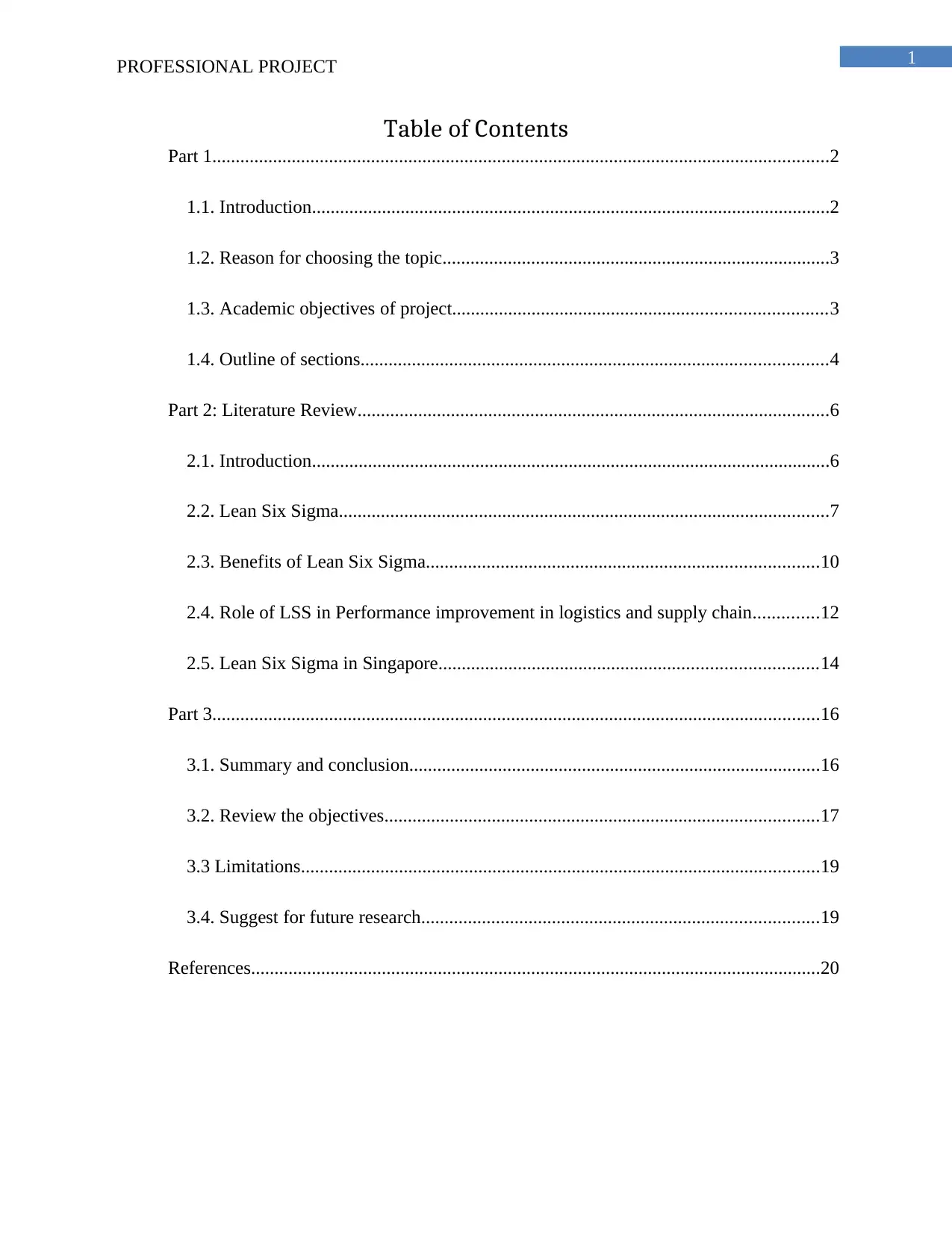
1PROFESSIONAL PROJECT
Table of Contents
Part 1....................................................................................................................................2
1.1. Introduction...............................................................................................................2
1.2. Reason for choosing the topic...................................................................................3
1.3. Academic objectives of project................................................................................3
1.4. Outline of sections....................................................................................................4
Part 2: Literature Review.....................................................................................................6
2.1. Introduction...............................................................................................................6
2.2. Lean Six Sigma.........................................................................................................7
2.3. Benefits of Lean Six Sigma....................................................................................10
2.4. Role of LSS in Performance improvement in logistics and supply chain..............12
2.5. Lean Six Sigma in Singapore.................................................................................14
Part 3..................................................................................................................................16
3.1. Summary and conclusion........................................................................................16
3.2. Review the objectives.............................................................................................17
3.3 Limitations...............................................................................................................19
3.4. Suggest for future research.....................................................................................19
References..........................................................................................................................20
Table of Contents
Part 1....................................................................................................................................2
1.1. Introduction...............................................................................................................2
1.2. Reason for choosing the topic...................................................................................3
1.3. Academic objectives of project................................................................................3
1.4. Outline of sections....................................................................................................4
Part 2: Literature Review.....................................................................................................6
2.1. Introduction...............................................................................................................6
2.2. Lean Six Sigma.........................................................................................................7
2.3. Benefits of Lean Six Sigma....................................................................................10
2.4. Role of LSS in Performance improvement in logistics and supply chain..............12
2.5. Lean Six Sigma in Singapore.................................................................................14
Part 3..................................................................................................................................16
3.1. Summary and conclusion........................................................................................16
3.2. Review the objectives.............................................................................................17
3.3 Limitations...............................................................................................................19
3.4. Suggest for future research.....................................................................................19
References..........................................................................................................................20
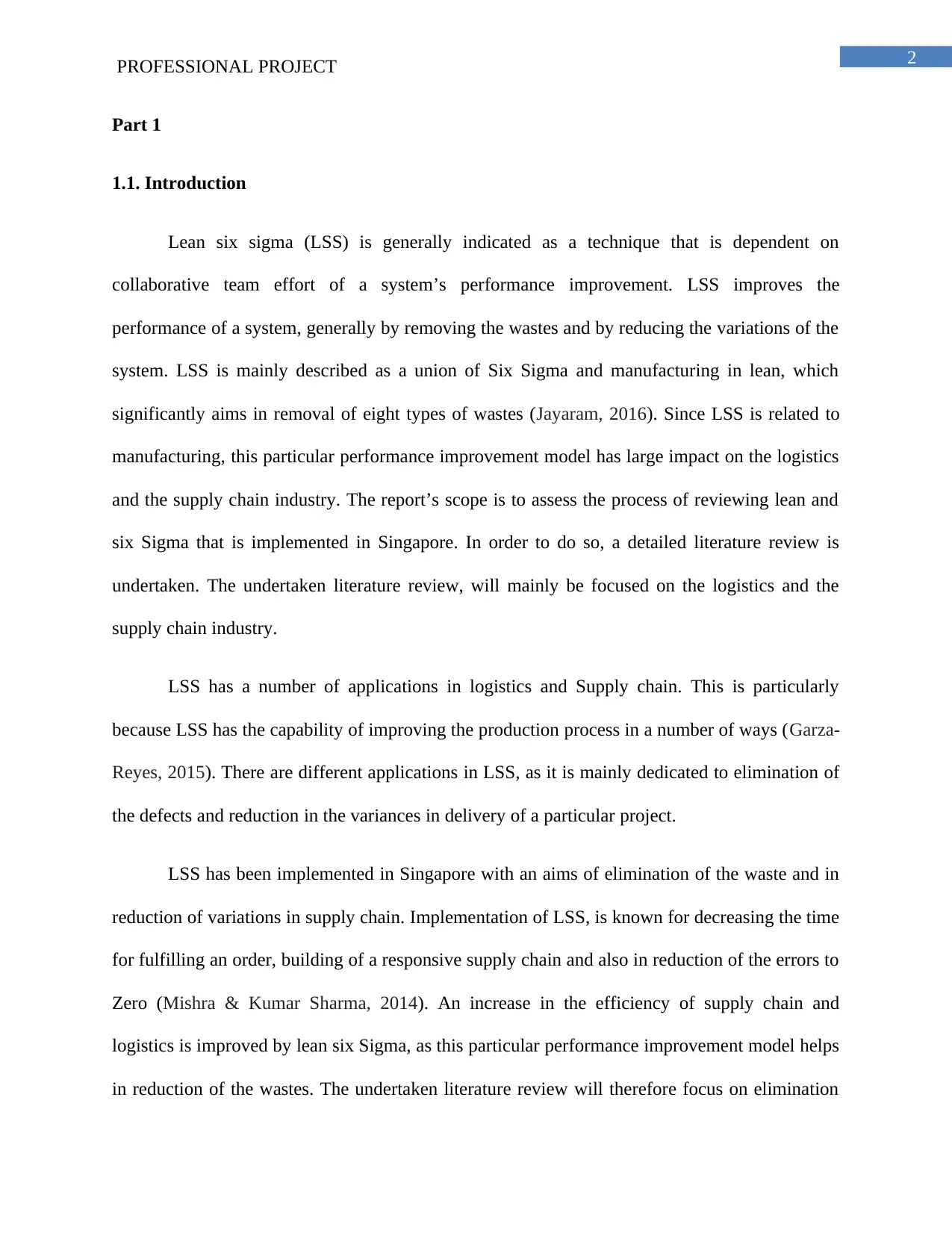
2PROFESSIONAL PROJECT
Part 1
1.1. Introduction
Lean six sigma (LSS) is generally indicated as a technique that is dependent on
collaborative team effort of a system’s performance improvement. LSS improves the
performance of a system, generally by removing the wastes and by reducing the variations of the
system. LSS is mainly described as a union of Six Sigma and manufacturing in lean, which
significantly aims in removal of eight types of wastes (Jayaram, 2016). Since LSS is related to
manufacturing, this particular performance improvement model has large impact on the logistics
and the supply chain industry. The report’s scope is to assess the process of reviewing lean and
six Sigma that is implemented in Singapore. In order to do so, a detailed literature review is
undertaken. The undertaken literature review, will mainly be focused on the logistics and the
supply chain industry.
LSS has a number of applications in logistics and Supply chain. This is particularly
because LSS has the capability of improving the production process in a number of ways (Garza-
Reyes, 2015). There are different applications in LSS, as it is mainly dedicated to elimination of
the defects and reduction in the variances in delivery of a particular project.
LSS has been implemented in Singapore with an aims of elimination of the waste and in
reduction of variations in supply chain. Implementation of LSS, is known for decreasing the time
for fulfilling an order, building of a responsive supply chain and also in reduction of the errors to
Zero (Mishra & Kumar Sharma, 2014). An increase in the efficiency of supply chain and
logistics is improved by lean six Sigma, as this particular performance improvement model helps
in reduction of the wastes. The undertaken literature review will therefore focus on elimination
Part 1
1.1. Introduction
Lean six sigma (LSS) is generally indicated as a technique that is dependent on
collaborative team effort of a system’s performance improvement. LSS improves the
performance of a system, generally by removing the wastes and by reducing the variations of the
system. LSS is mainly described as a union of Six Sigma and manufacturing in lean, which
significantly aims in removal of eight types of wastes (Jayaram, 2016). Since LSS is related to
manufacturing, this particular performance improvement model has large impact on the logistics
and the supply chain industry. The report’s scope is to assess the process of reviewing lean and
six Sigma that is implemented in Singapore. In order to do so, a detailed literature review is
undertaken. The undertaken literature review, will mainly be focused on the logistics and the
supply chain industry.
LSS has a number of applications in logistics and Supply chain. This is particularly
because LSS has the capability of improving the production process in a number of ways (Garza-
Reyes, 2015). There are different applications in LSS, as it is mainly dedicated to elimination of
the defects and reduction in the variances in delivery of a particular project.
LSS has been implemented in Singapore with an aims of elimination of the waste and in
reduction of variations in supply chain. Implementation of LSS, is known for decreasing the time
for fulfilling an order, building of a responsive supply chain and also in reduction of the errors to
Zero (Mishra & Kumar Sharma, 2014). An increase in the efficiency of supply chain and
logistics is improved by lean six Sigma, as this particular performance improvement model helps
in reduction of the wastes. The undertaken literature review will therefore focus on elimination
⊘ This is a preview!⊘
Do you want full access?
Subscribe today to unlock all pages.

Trusted by 1+ million students worldwide
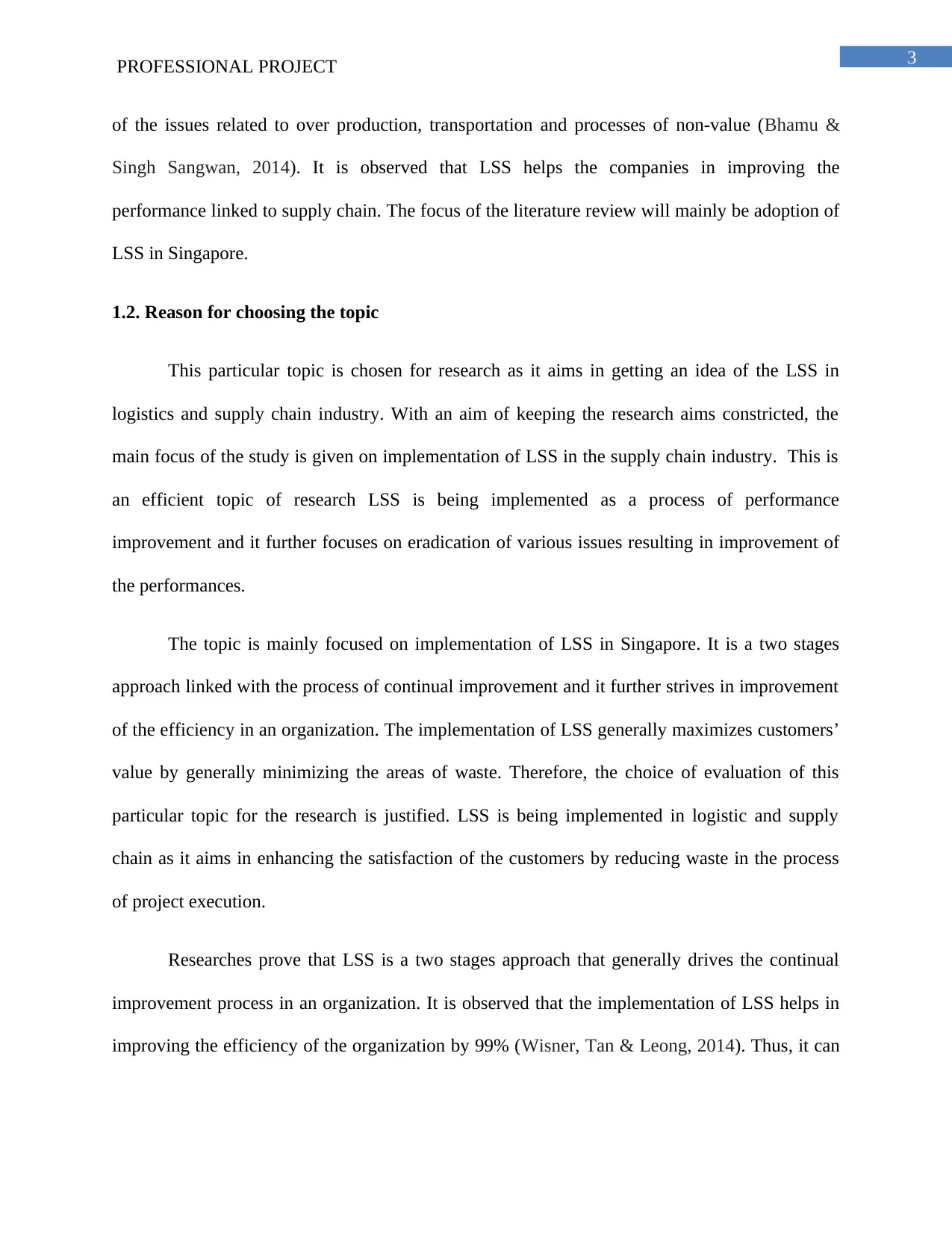
3PROFESSIONAL PROJECT
of the issues related to over production, transportation and processes of non-value (Bhamu &
Singh Sangwan, 2014). It is observed that LSS helps the companies in improving the
performance linked to supply chain. The focus of the literature review will mainly be adoption of
LSS in Singapore.
1.2. Reason for choosing the topic
This particular topic is chosen for research as it aims in getting an idea of the LSS in
logistics and supply chain industry. With an aim of keeping the research aims constricted, the
main focus of the study is given on implementation of LSS in the supply chain industry. This is
an efficient topic of research LSS is being implemented as a process of performance
improvement and it further focuses on eradication of various issues resulting in improvement of
the performances.
The topic is mainly focused on implementation of LSS in Singapore. It is a two stages
approach linked with the process of continual improvement and it further strives in improvement
of the efficiency in an organization. The implementation of LSS generally maximizes customers’
value by generally minimizing the areas of waste. Therefore, the choice of evaluation of this
particular topic for the research is justified. LSS is being implemented in logistic and supply
chain as it aims in enhancing the satisfaction of the customers by reducing waste in the process
of project execution.
Researches prove that LSS is a two stages approach that generally drives the continual
improvement process in an organization. It is observed that the implementation of LSS helps in
improving the efficiency of the organization by 99% (Wisner, Tan & Leong, 2014). Thus, it can
of the issues related to over production, transportation and processes of non-value (Bhamu &
Singh Sangwan, 2014). It is observed that LSS helps the companies in improving the
performance linked to supply chain. The focus of the literature review will mainly be adoption of
LSS in Singapore.
1.2. Reason for choosing the topic
This particular topic is chosen for research as it aims in getting an idea of the LSS in
logistics and supply chain industry. With an aim of keeping the research aims constricted, the
main focus of the study is given on implementation of LSS in the supply chain industry. This is
an efficient topic of research LSS is being implemented as a process of performance
improvement and it further focuses on eradication of various issues resulting in improvement of
the performances.
The topic is mainly focused on implementation of LSS in Singapore. It is a two stages
approach linked with the process of continual improvement and it further strives in improvement
of the efficiency in an organization. The implementation of LSS generally maximizes customers’
value by generally minimizing the areas of waste. Therefore, the choice of evaluation of this
particular topic for the research is justified. LSS is being implemented in logistic and supply
chain as it aims in enhancing the satisfaction of the customers by reducing waste in the process
of project execution.
Researches prove that LSS is a two stages approach that generally drives the continual
improvement process in an organization. It is observed that the implementation of LSS helps in
improving the efficiency of the organization by 99% (Wisner, Tan & Leong, 2014). Thus, it can
Paraphrase This Document
Need a fresh take? Get an instant paraphrase of this document with our AI Paraphraser
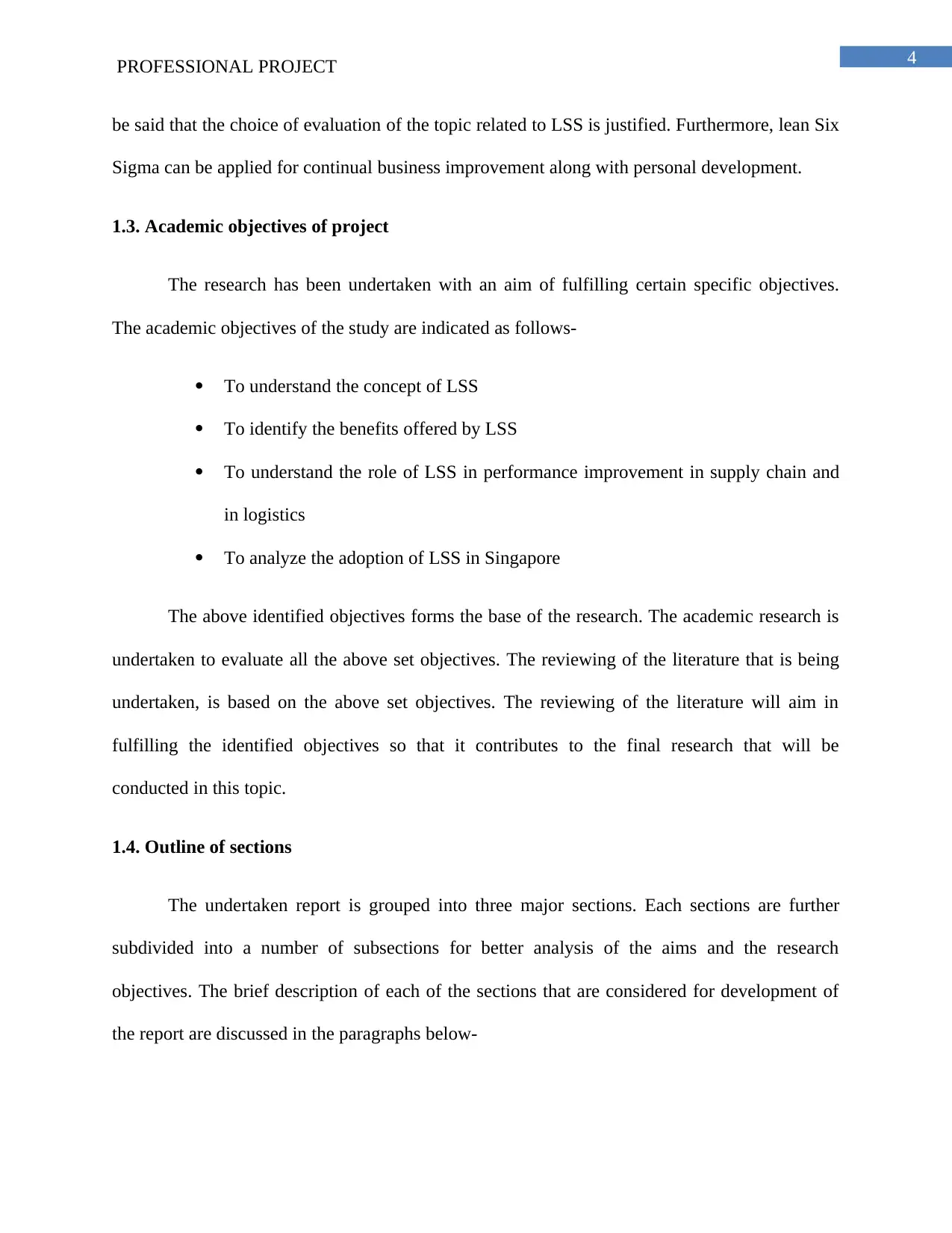
4PROFESSIONAL PROJECT
be said that the choice of evaluation of the topic related to LSS is justified. Furthermore, lean Six
Sigma can be applied for continual business improvement along with personal development.
1.3. Academic objectives of project
The research has been undertaken with an aim of fulfilling certain specific objectives.
The academic objectives of the study are indicated as follows-
To understand the concept of LSS
To identify the benefits offered by LSS
To understand the role of LSS in performance improvement in supply chain and
in logistics
To analyze the adoption of LSS in Singapore
The above identified objectives forms the base of the research. The academic research is
undertaken to evaluate all the above set objectives. The reviewing of the literature that is being
undertaken, is based on the above set objectives. The reviewing of the literature will aim in
fulfilling the identified objectives so that it contributes to the final research that will be
conducted in this topic.
1.4. Outline of sections
The undertaken report is grouped into three major sections. Each sections are further
subdivided into a number of subsections for better analysis of the aims and the research
objectives. The brief description of each of the sections that are considered for development of
the report are discussed in the paragraphs below-
be said that the choice of evaluation of the topic related to LSS is justified. Furthermore, lean Six
Sigma can be applied for continual business improvement along with personal development.
1.3. Academic objectives of project
The research has been undertaken with an aim of fulfilling certain specific objectives.
The academic objectives of the study are indicated as follows-
To understand the concept of LSS
To identify the benefits offered by LSS
To understand the role of LSS in performance improvement in supply chain and
in logistics
To analyze the adoption of LSS in Singapore
The above identified objectives forms the base of the research. The academic research is
undertaken to evaluate all the above set objectives. The reviewing of the literature that is being
undertaken, is based on the above set objectives. The reviewing of the literature will aim in
fulfilling the identified objectives so that it contributes to the final research that will be
conducted in this topic.
1.4. Outline of sections
The undertaken report is grouped into three major sections. Each sections are further
subdivided into a number of subsections for better analysis of the aims and the research
objectives. The brief description of each of the sections that are considered for development of
the report are discussed in the paragraphs below-
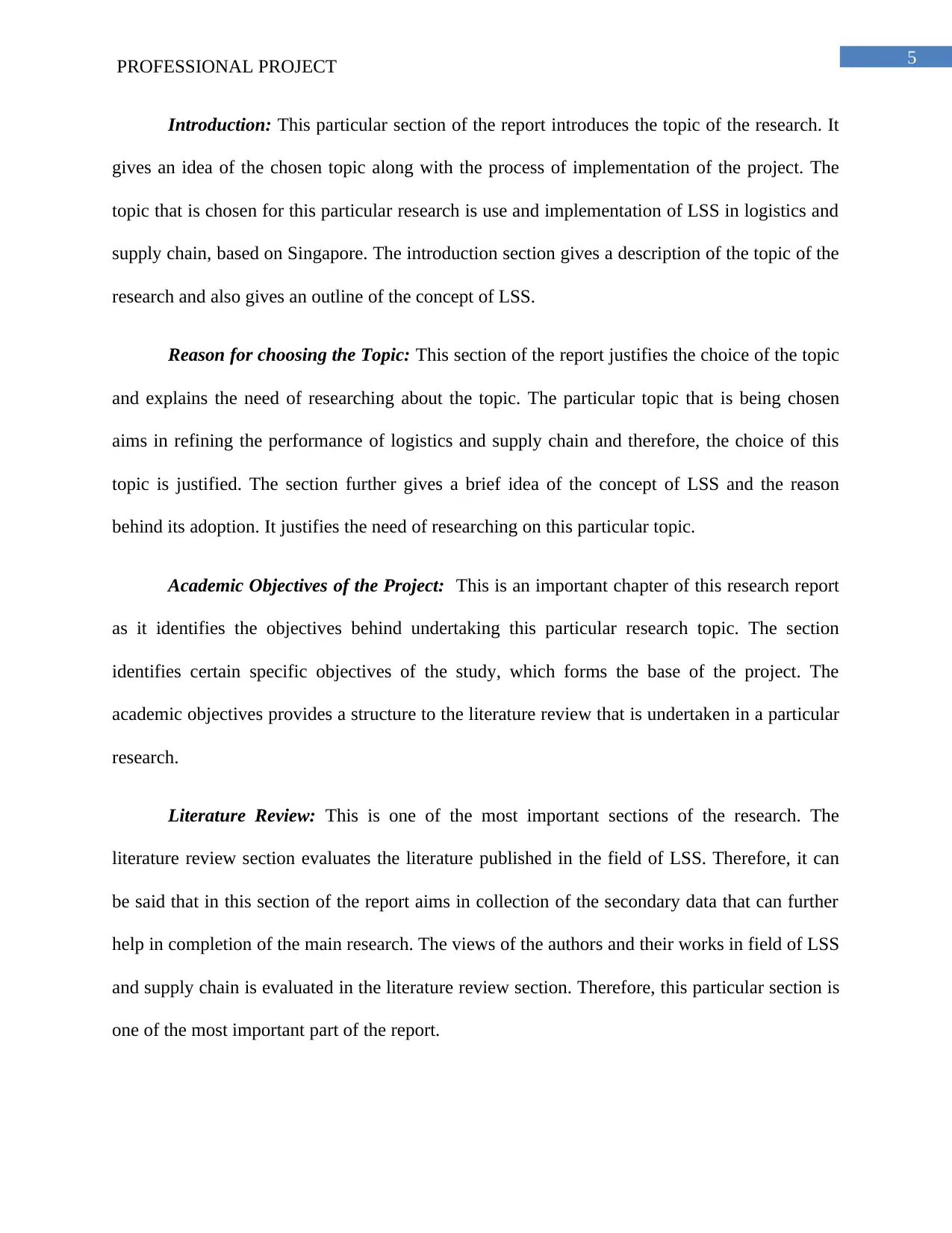
5PROFESSIONAL PROJECT
Introduction: This particular section of the report introduces the topic of the research. It
gives an idea of the chosen topic along with the process of implementation of the project. The
topic that is chosen for this particular research is use and implementation of LSS in logistics and
supply chain, based on Singapore. The introduction section gives a description of the topic of the
research and also gives an outline of the concept of LSS.
Reason for choosing the Topic: This section of the report justifies the choice of the topic
and explains the need of researching about the topic. The particular topic that is being chosen
aims in refining the performance of logistics and supply chain and therefore, the choice of this
topic is justified. The section further gives a brief idea of the concept of LSS and the reason
behind its adoption. It justifies the need of researching on this particular topic.
Academic Objectives of the Project: This is an important chapter of this research report
as it identifies the objectives behind undertaking this particular research topic. The section
identifies certain specific objectives of the study, which forms the base of the project. The
academic objectives provides a structure to the literature review that is undertaken in a particular
research.
Literature Review: This is one of the most important sections of the research. The
literature review section evaluates the literature published in the field of LSS. Therefore, it can
be said that in this section of the report aims in collection of the secondary data that can further
help in completion of the main research. The views of the authors and their works in field of LSS
and supply chain is evaluated in the literature review section. Therefore, this particular section is
one of the most important part of the report.
Introduction: This particular section of the report introduces the topic of the research. It
gives an idea of the chosen topic along with the process of implementation of the project. The
topic that is chosen for this particular research is use and implementation of LSS in logistics and
supply chain, based on Singapore. The introduction section gives a description of the topic of the
research and also gives an outline of the concept of LSS.
Reason for choosing the Topic: This section of the report justifies the choice of the topic
and explains the need of researching about the topic. The particular topic that is being chosen
aims in refining the performance of logistics and supply chain and therefore, the choice of this
topic is justified. The section further gives a brief idea of the concept of LSS and the reason
behind its adoption. It justifies the need of researching on this particular topic.
Academic Objectives of the Project: This is an important chapter of this research report
as it identifies the objectives behind undertaking this particular research topic. The section
identifies certain specific objectives of the study, which forms the base of the project. The
academic objectives provides a structure to the literature review that is undertaken in a particular
research.
Literature Review: This is one of the most important sections of the research. The
literature review section evaluates the literature published in the field of LSS. Therefore, it can
be said that in this section of the report aims in collection of the secondary data that can further
help in completion of the main research. The views of the authors and their works in field of LSS
and supply chain is evaluated in the literature review section. Therefore, this particular section is
one of the most important part of the report.
⊘ This is a preview!⊘
Do you want full access?
Subscribe today to unlock all pages.

Trusted by 1+ million students worldwide
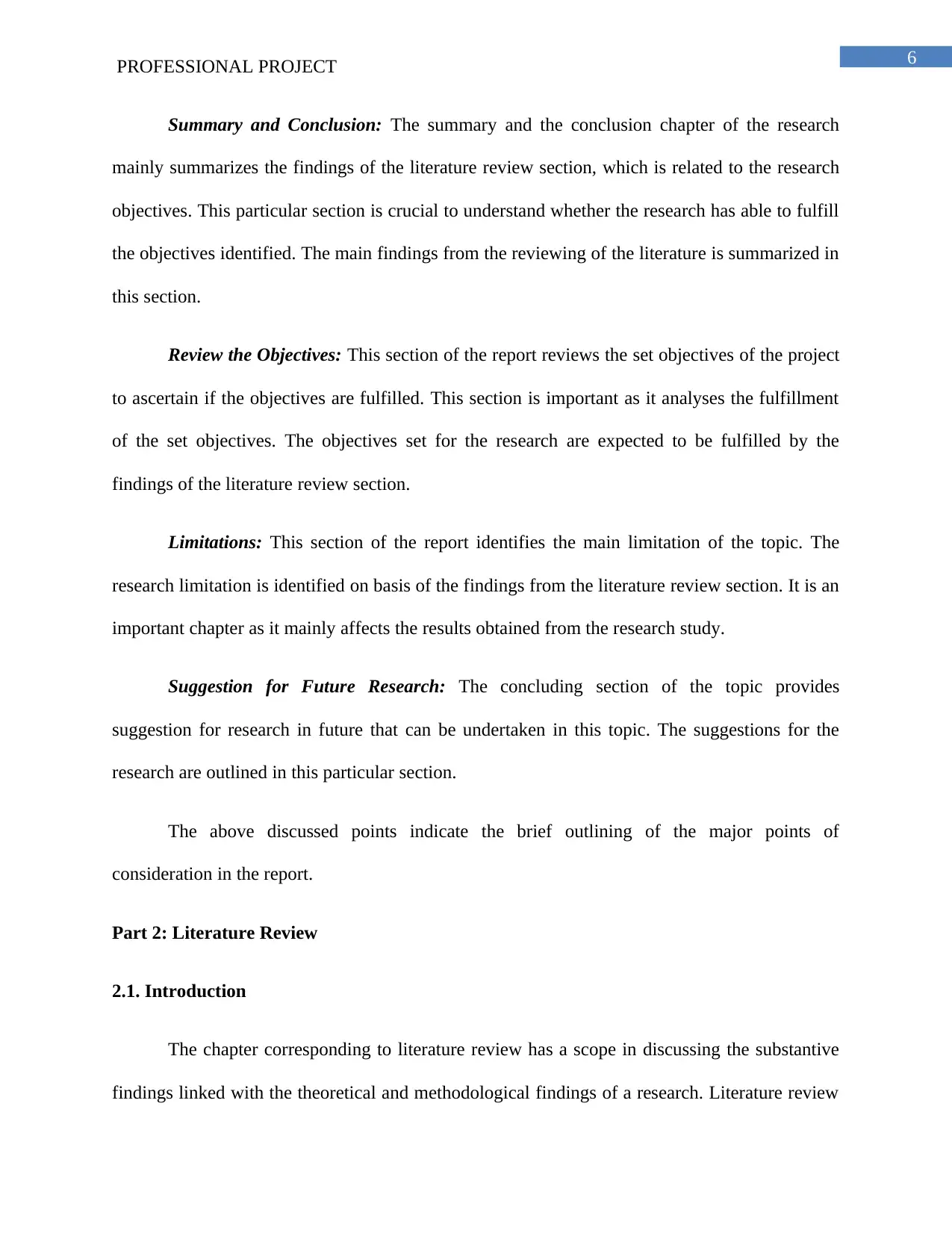
6PROFESSIONAL PROJECT
Summary and Conclusion: The summary and the conclusion chapter of the research
mainly summarizes the findings of the literature review section, which is related to the research
objectives. This particular section is crucial to understand whether the research has able to fulfill
the objectives identified. The main findings from the reviewing of the literature is summarized in
this section.
Review the Objectives: This section of the report reviews the set objectives of the project
to ascertain if the objectives are fulfilled. This section is important as it analyses the fulfillment
of the set objectives. The objectives set for the research are expected to be fulfilled by the
findings of the literature review section.
Limitations: This section of the report identifies the main limitation of the topic. The
research limitation is identified on basis of the findings from the literature review section. It is an
important chapter as it mainly affects the results obtained from the research study.
Suggestion for Future Research: The concluding section of the topic provides
suggestion for research in future that can be undertaken in this topic. The suggestions for the
research are outlined in this particular section.
The above discussed points indicate the brief outlining of the major points of
consideration in the report.
Part 2: Literature Review
2.1. Introduction
The chapter corresponding to literature review has a scope in discussing the substantive
findings linked with the theoretical and methodological findings of a research. Literature review
Summary and Conclusion: The summary and the conclusion chapter of the research
mainly summarizes the findings of the literature review section, which is related to the research
objectives. This particular section is crucial to understand whether the research has able to fulfill
the objectives identified. The main findings from the reviewing of the literature is summarized in
this section.
Review the Objectives: This section of the report reviews the set objectives of the project
to ascertain if the objectives are fulfilled. This section is important as it analyses the fulfillment
of the set objectives. The objectives set for the research are expected to be fulfilled by the
findings of the literature review section.
Limitations: This section of the report identifies the main limitation of the topic. The
research limitation is identified on basis of the findings from the literature review section. It is an
important chapter as it mainly affects the results obtained from the research study.
Suggestion for Future Research: The concluding section of the topic provides
suggestion for research in future that can be undertaken in this topic. The suggestions for the
research are outlined in this particular section.
The above discussed points indicate the brief outlining of the major points of
consideration in the report.
Part 2: Literature Review
2.1. Introduction
The chapter corresponding to literature review has a scope in discussing the substantive
findings linked with the theoretical and methodological findings of a research. Literature review
Paraphrase This Document
Need a fresh take? Get an instant paraphrase of this document with our AI Paraphraser
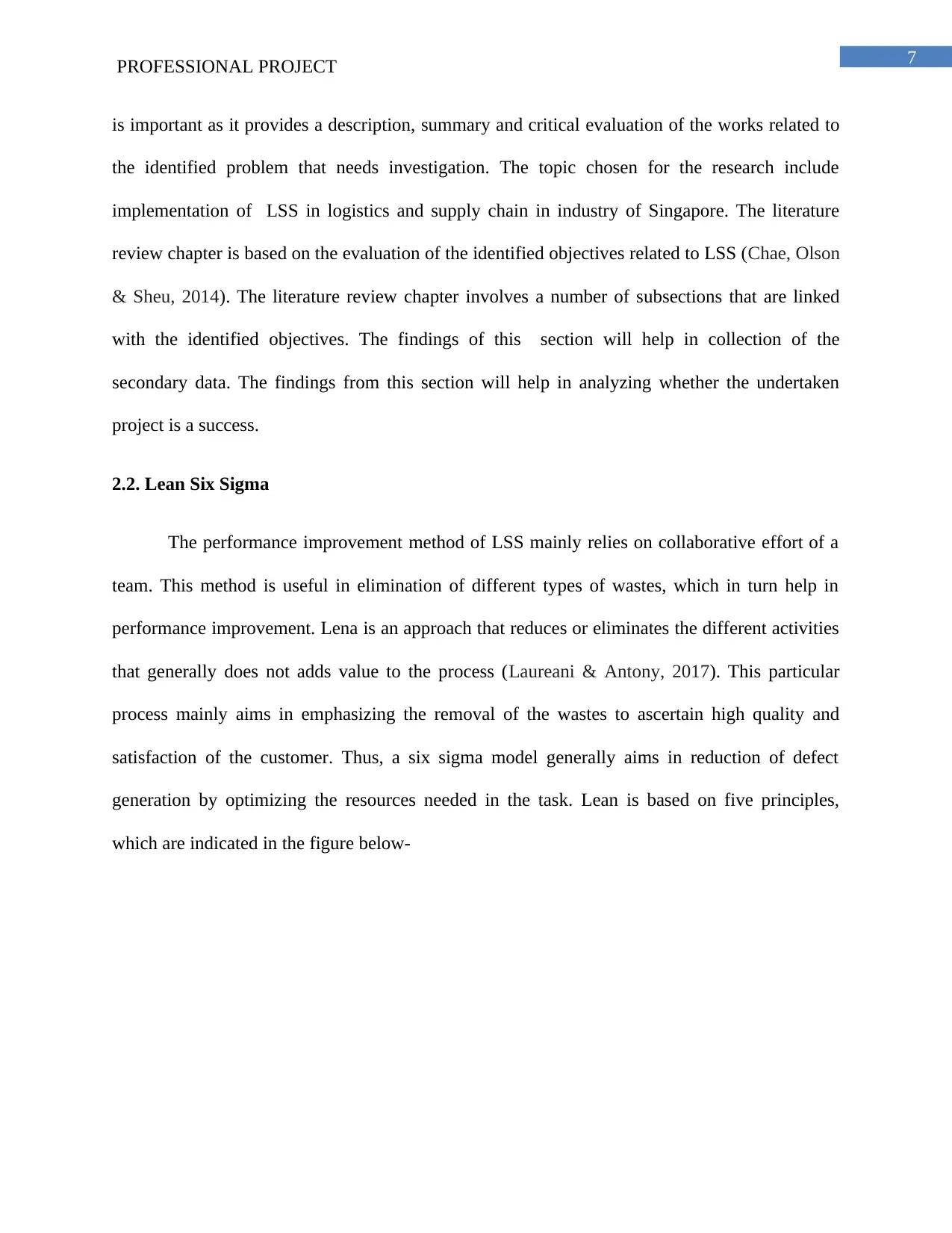
7PROFESSIONAL PROJECT
is important as it provides a description, summary and critical evaluation of the works related to
the identified problem that needs investigation. The topic chosen for the research include
implementation of LSS in logistics and supply chain in industry of Singapore. The literature
review chapter is based on the evaluation of the identified objectives related to LSS (Chae, Olson
& Sheu, 2014). The literature review chapter involves a number of subsections that are linked
with the identified objectives. The findings of this section will help in collection of the
secondary data. The findings from this section will help in analyzing whether the undertaken
project is a success.
2.2. Lean Six Sigma
The performance improvement method of LSS mainly relies on collaborative effort of a
team. This method is useful in elimination of different types of wastes, which in turn help in
performance improvement. Lena is an approach that reduces or eliminates the different activities
that generally does not adds value to the process (Laureani & Antony, 2017). This particular
process mainly aims in emphasizing the removal of the wastes to ascertain high quality and
satisfaction of the customer. Thus, a six sigma model generally aims in reduction of defect
generation by optimizing the resources needed in the task. Lean is based on five principles,
which are indicated in the figure below-
is important as it provides a description, summary and critical evaluation of the works related to
the identified problem that needs investigation. The topic chosen for the research include
implementation of LSS in logistics and supply chain in industry of Singapore. The literature
review chapter is based on the evaluation of the identified objectives related to LSS (Chae, Olson
& Sheu, 2014). The literature review chapter involves a number of subsections that are linked
with the identified objectives. The findings of this section will help in collection of the
secondary data. The findings from this section will help in analyzing whether the undertaken
project is a success.
2.2. Lean Six Sigma
The performance improvement method of LSS mainly relies on collaborative effort of a
team. This method is useful in elimination of different types of wastes, which in turn help in
performance improvement. Lena is an approach that reduces or eliminates the different activities
that generally does not adds value to the process (Laureani & Antony, 2017). This particular
process mainly aims in emphasizing the removal of the wastes to ascertain high quality and
satisfaction of the customer. Thus, a six sigma model generally aims in reduction of defect
generation by optimizing the resources needed in the task. Lean is based on five principles,
which are indicated in the figure below-
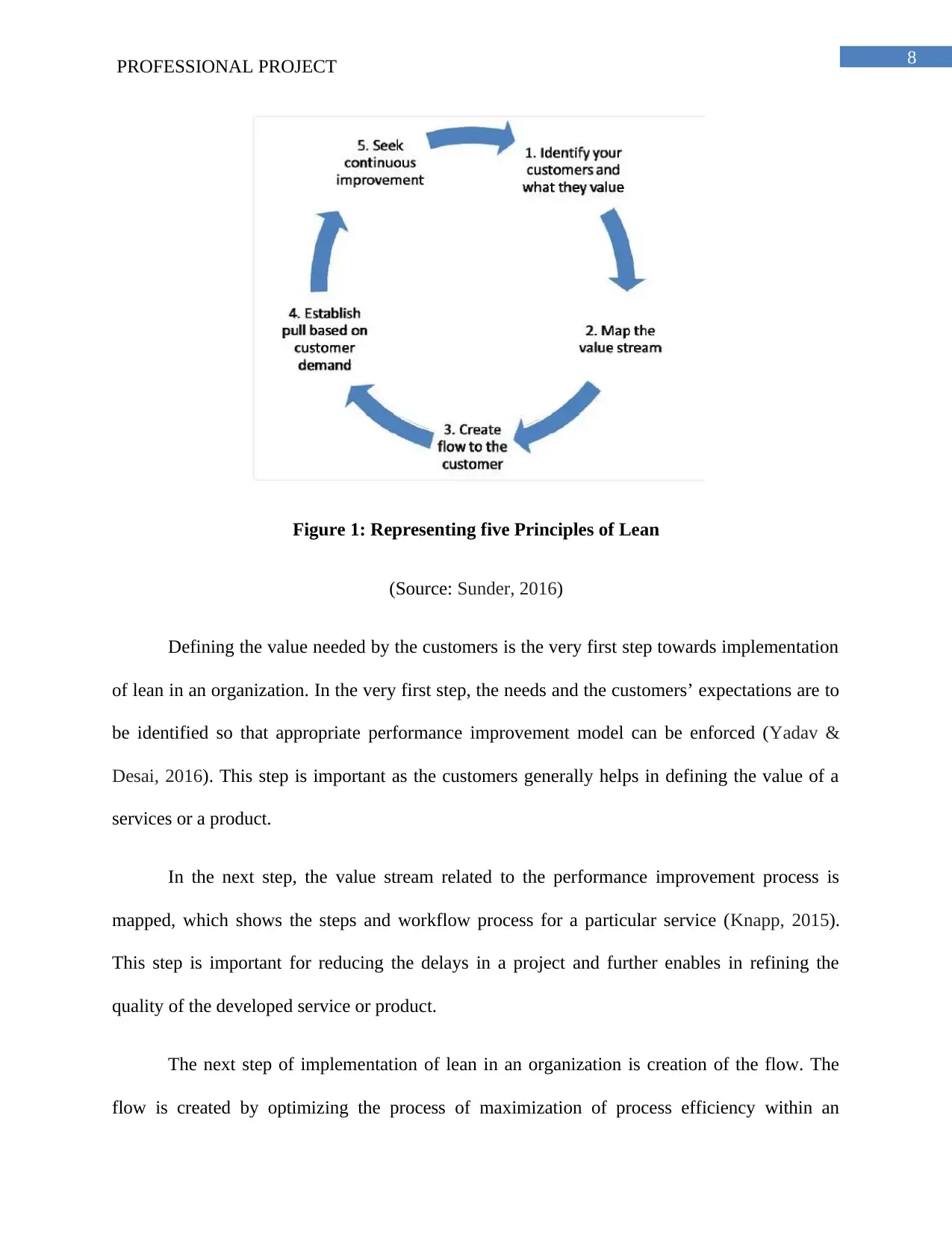
8PROFESSIONAL PROJECT
Figure 1: Representing five Principles of Lean
(Source: Sunder, 2016)
Defining the value needed by the customers is the very first step towards implementation
of lean in an organization. In the very first step, the needs and the customers’ expectations are to
be identified so that appropriate performance improvement model can be enforced (Yadav &
Desai, 2016). This step is important as the customers generally helps in defining the value of a
services or a product.
In the next step, the value stream related to the performance improvement process is
mapped, which shows the steps and workflow process for a particular service (Knapp, 2015).
This step is important for reducing the delays in a project and further enables in refining the
quality of the developed service or product.
The next step of implementation of lean in an organization is creation of the flow. The
flow is created by optimizing the process of maximization of process efficiency within an
Figure 1: Representing five Principles of Lean
(Source: Sunder, 2016)
Defining the value needed by the customers is the very first step towards implementation
of lean in an organization. In the very first step, the needs and the customers’ expectations are to
be identified so that appropriate performance improvement model can be enforced (Yadav &
Desai, 2016). This step is important as the customers generally helps in defining the value of a
services or a product.
In the next step, the value stream related to the performance improvement process is
mapped, which shows the steps and workflow process for a particular service (Knapp, 2015).
This step is important for reducing the delays in a project and further enables in refining the
quality of the developed service or product.
The next step of implementation of lean in an organization is creation of the flow. The
flow is created by optimizing the process of maximization of process efficiency within an
⊘ This is a preview!⊘
Do you want full access?
Subscribe today to unlock all pages.

Trusted by 1+ million students worldwide
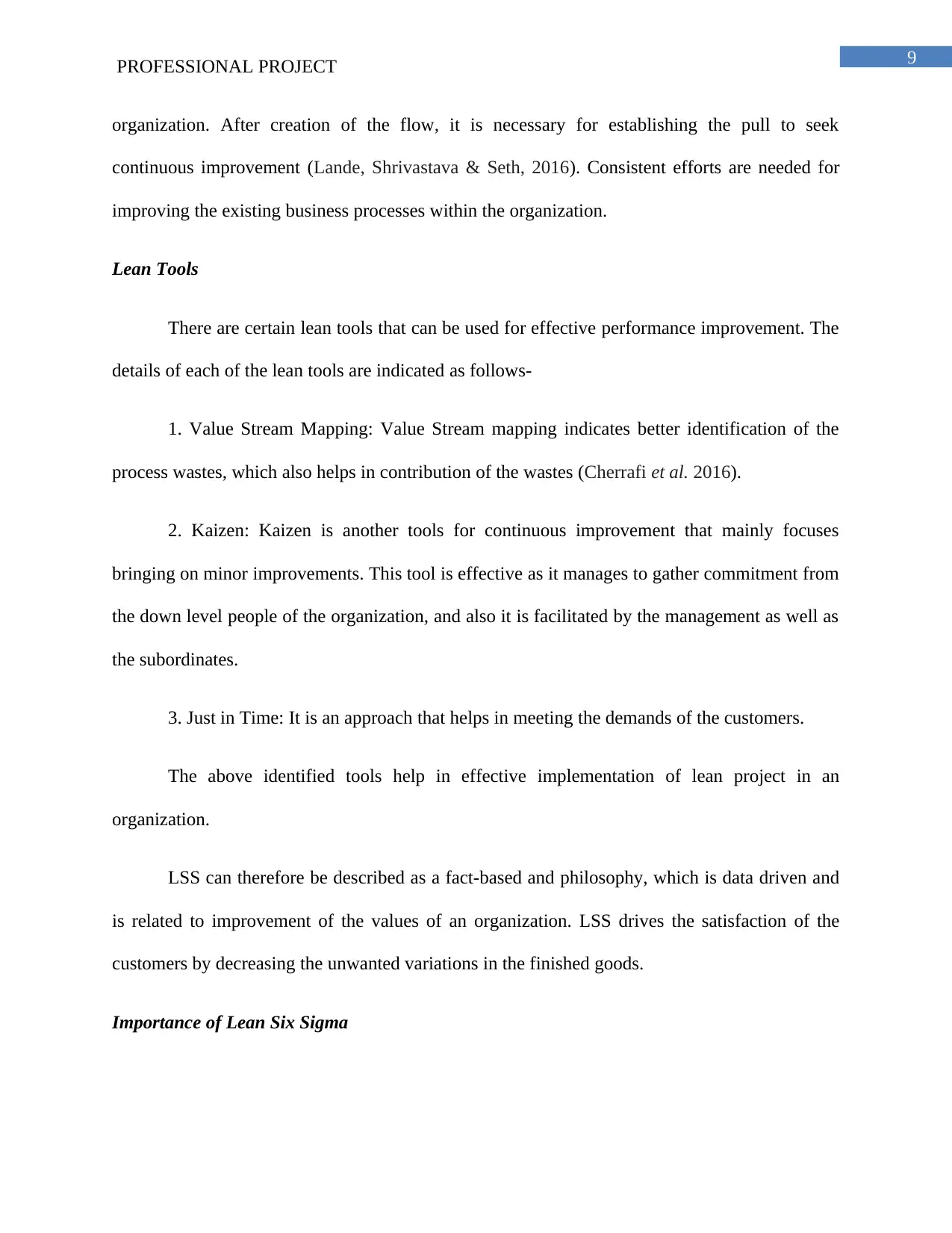
9PROFESSIONAL PROJECT
organization. After creation of the flow, it is necessary for establishing the pull to seek
continuous improvement (Lande, Shrivastava & Seth, 2016). Consistent efforts are needed for
improving the existing business processes within the organization.
Lean Tools
There are certain lean tools that can be used for effective performance improvement. The
details of each of the lean tools are indicated as follows-
1. Value Stream Mapping: Value Stream mapping indicates better identification of the
process wastes, which also helps in contribution of the wastes (Cherrafi et al. 2016).
2. Kaizen: Kaizen is another tools for continuous improvement that mainly focuses
bringing on minor improvements. This tool is effective as it manages to gather commitment from
the down level people of the organization, and also it is facilitated by the management as well as
the subordinates.
3. Just in Time: It is an approach that helps in meeting the demands of the customers.
The above identified tools help in effective implementation of lean project in an
organization.
LSS can therefore be described as a fact-based and philosophy, which is data driven and
is related to improvement of the values of an organization. LSS drives the satisfaction of the
customers by decreasing the unwanted variations in the finished goods.
Importance of Lean Six Sigma
organization. After creation of the flow, it is necessary for establishing the pull to seek
continuous improvement (Lande, Shrivastava & Seth, 2016). Consistent efforts are needed for
improving the existing business processes within the organization.
Lean Tools
There are certain lean tools that can be used for effective performance improvement. The
details of each of the lean tools are indicated as follows-
1. Value Stream Mapping: Value Stream mapping indicates better identification of the
process wastes, which also helps in contribution of the wastes (Cherrafi et al. 2016).
2. Kaizen: Kaizen is another tools for continuous improvement that mainly focuses
bringing on minor improvements. This tool is effective as it manages to gather commitment from
the down level people of the organization, and also it is facilitated by the management as well as
the subordinates.
3. Just in Time: It is an approach that helps in meeting the demands of the customers.
The above identified tools help in effective implementation of lean project in an
organization.
LSS can therefore be described as a fact-based and philosophy, which is data driven and
is related to improvement of the values of an organization. LSS drives the satisfaction of the
customers by decreasing the unwanted variations in the finished goods.
Importance of Lean Six Sigma
Paraphrase This Document
Need a fresh take? Get an instant paraphrase of this document with our AI Paraphraser

10PROFESSIONAL PROJECT
The LSS is gaining importance in Singapore particularly because it has a number of
applications in the dynamic environment (Abu Bakar, Subari & Mohd Daril, 2015). Application
of LSS generally ascertains improvements in the project management approach in an exceptional
manner and also in the removal of wastes. LSS is generally considered to be a continuous
process where the complexity of the project is reduced (Furterer, 2016). The integrated
exceptional approach is used in sectors and industries across Singapore to promote effective
changes in the performance level of an organization. The LSS is therefore known for improving
the efficiency of the processes.
The efficiency in the process is improved mainly because it helps in increased employee
involvement along with reduction of the costs of implementation of new process within an
organization. LSS is further important for reduction of costs that benefits an organization
(Gutierrez-Gutierrez, De Leeuw & Dubbers, 2016). The reduction in the costs is mainly possible
because it helps in decrease of the defects and errors, thus reducing the requirement of rework.
The Lean six Sigma model is significantly used for decreasing he cost of execution of a project,
which in turn increases the customer value. This is related to the benefit of increased customer
satisfaction that is linked with the execution and correct implementation of a project (Gutierrez-
Gutierrez, De Leeuw & Dubbers, 2016). LSS mainly focuses on effective product improvements
along with the methods of product delivery. Increase in satisfaction of the customer results in
increase in the sales thus improving the business benefits of the organization.
Six Sigma is a methodology that is generally used for improving analyzing and
measuring the performance of an organization. It helps in improving the business processes by
using statistical analysis and highly discipline methodology (Abu Bakar, Subari & Mohd Daril,
2015). The LSS process is largely data driven and it ascertains elimination of the defects linked
The LSS is gaining importance in Singapore particularly because it has a number of
applications in the dynamic environment (Abu Bakar, Subari & Mohd Daril, 2015). Application
of LSS generally ascertains improvements in the project management approach in an exceptional
manner and also in the removal of wastes. LSS is generally considered to be a continuous
process where the complexity of the project is reduced (Furterer, 2016). The integrated
exceptional approach is used in sectors and industries across Singapore to promote effective
changes in the performance level of an organization. The LSS is therefore known for improving
the efficiency of the processes.
The efficiency in the process is improved mainly because it helps in increased employee
involvement along with reduction of the costs of implementation of new process within an
organization. LSS is further important for reduction of costs that benefits an organization
(Gutierrez-Gutierrez, De Leeuw & Dubbers, 2016). The reduction in the costs is mainly possible
because it helps in decrease of the defects and errors, thus reducing the requirement of rework.
The Lean six Sigma model is significantly used for decreasing he cost of execution of a project,
which in turn increases the customer value. This is related to the benefit of increased customer
satisfaction that is linked with the execution and correct implementation of a project (Gutierrez-
Gutierrez, De Leeuw & Dubbers, 2016). LSS mainly focuses on effective product improvements
along with the methods of product delivery. Increase in satisfaction of the customer results in
increase in the sales thus improving the business benefits of the organization.
Six Sigma is a methodology that is generally used for improving analyzing and
measuring the performance of an organization. It helps in improving the business processes by
using statistical analysis and highly discipline methodology (Abu Bakar, Subari & Mohd Daril,
2015). The LSS process is largely data driven and it ascertains elimination of the defects linked
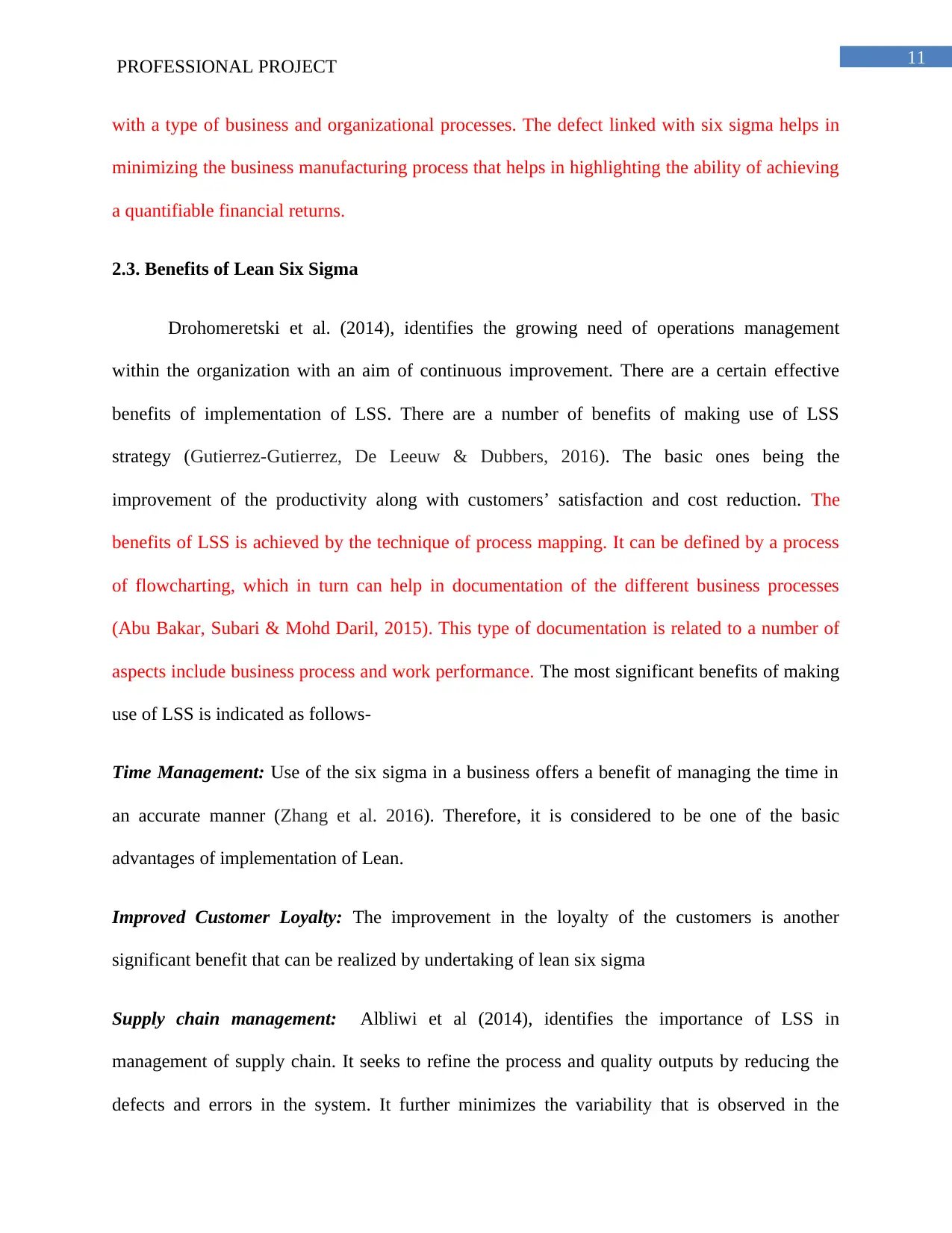
11PROFESSIONAL PROJECT
with a type of business and organizational processes. The defect linked with six sigma helps in
minimizing the business manufacturing process that helps in highlighting the ability of achieving
a quantifiable financial returns.
2.3. Benefits of Lean Six Sigma
Drohomeretski et al. (2014), identifies the growing need of operations management
within the organization with an aim of continuous improvement. There are a certain effective
benefits of implementation of LSS. There are a number of benefits of making use of LSS
strategy (Gutierrez-Gutierrez, De Leeuw & Dubbers, 2016). The basic ones being the
improvement of the productivity along with customers’ satisfaction and cost reduction. The
benefits of LSS is achieved by the technique of process mapping. It can be defined by a process
of flowcharting, which in turn can help in documentation of the different business processes
(Abu Bakar, Subari & Mohd Daril, 2015). This type of documentation is related to a number of
aspects include business process and work performance. The most significant benefits of making
use of LSS is indicated as follows-
Time Management: Use of the six sigma in a business offers a benefit of managing the time in
an accurate manner (Zhang et al. 2016). Therefore, it is considered to be one of the basic
advantages of implementation of Lean.
Improved Customer Loyalty: The improvement in the loyalty of the customers is another
significant benefit that can be realized by undertaking of lean six sigma
Supply chain management: Albliwi et al (2014), identifies the importance of LSS in
management of supply chain. It seeks to refine the process and quality outputs by reducing the
defects and errors in the system. It further minimizes the variability that is observed in the
with a type of business and organizational processes. The defect linked with six sigma helps in
minimizing the business manufacturing process that helps in highlighting the ability of achieving
a quantifiable financial returns.
2.3. Benefits of Lean Six Sigma
Drohomeretski et al. (2014), identifies the growing need of operations management
within the organization with an aim of continuous improvement. There are a certain effective
benefits of implementation of LSS. There are a number of benefits of making use of LSS
strategy (Gutierrez-Gutierrez, De Leeuw & Dubbers, 2016). The basic ones being the
improvement of the productivity along with customers’ satisfaction and cost reduction. The
benefits of LSS is achieved by the technique of process mapping. It can be defined by a process
of flowcharting, which in turn can help in documentation of the different business processes
(Abu Bakar, Subari & Mohd Daril, 2015). This type of documentation is related to a number of
aspects include business process and work performance. The most significant benefits of making
use of LSS is indicated as follows-
Time Management: Use of the six sigma in a business offers a benefit of managing the time in
an accurate manner (Zhang et al. 2016). Therefore, it is considered to be one of the basic
advantages of implementation of Lean.
Improved Customer Loyalty: The improvement in the loyalty of the customers is another
significant benefit that can be realized by undertaking of lean six sigma
Supply chain management: Albliwi et al (2014), identifies the importance of LSS in
management of supply chain. It seeks to refine the process and quality outputs by reducing the
defects and errors in the system. It further minimizes the variability that is observed in the
⊘ This is a preview!⊘
Do you want full access?
Subscribe today to unlock all pages.

Trusted by 1+ million students worldwide
1 out of 24
Related Documents
Your All-in-One AI-Powered Toolkit for Academic Success.
+13062052269
info@desklib.com
Available 24*7 on WhatsApp / Email
![[object Object]](/_next/static/media/star-bottom.7253800d.svg)
Unlock your academic potential
Copyright © 2020–2025 A2Z Services. All Rights Reserved. Developed and managed by ZUCOL.





